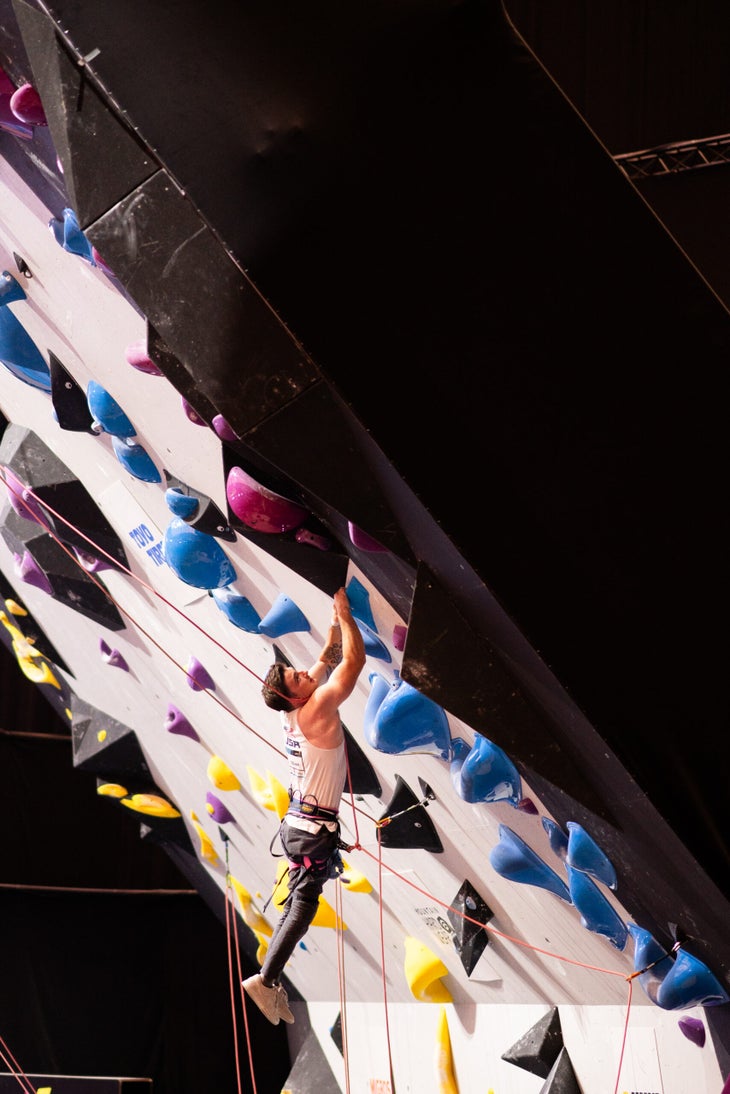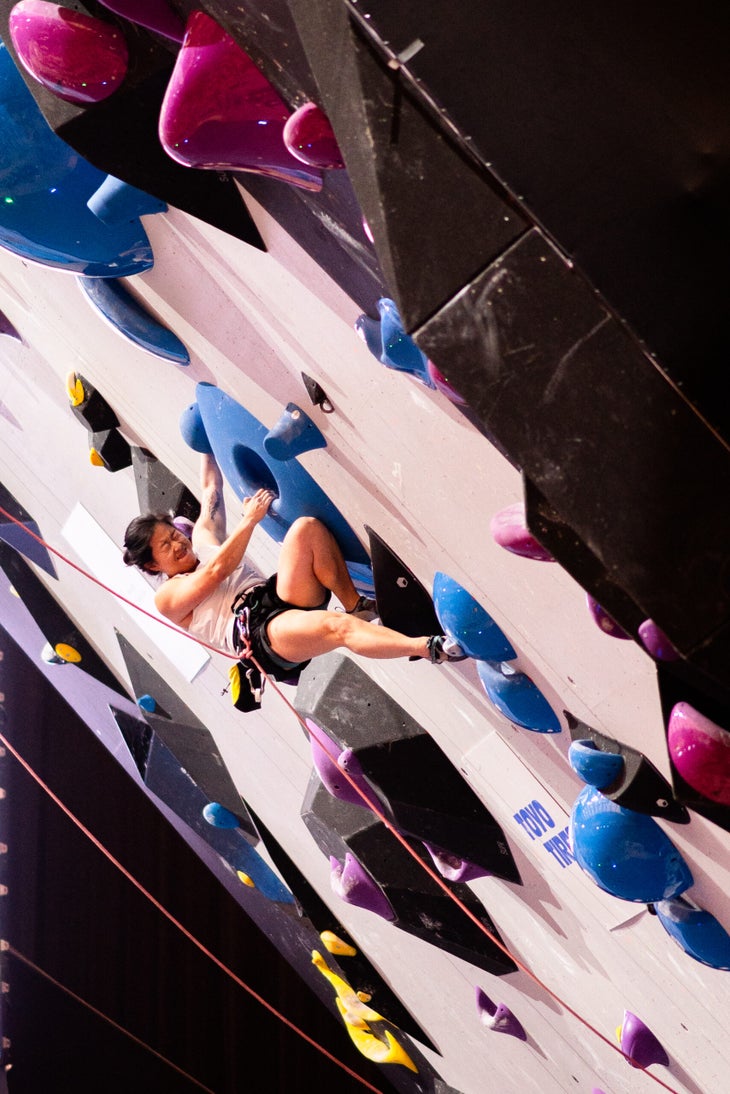Heading out the door? Read this article on the new Outside+ app available now on iOS devices for members! Download the app.
The final event of this year’s competitive climbing season swung into Switzerland with the World Championships taking over Bern for the first half of August. World Championships only take place every two years, adding to the significance of this already historic event, which boasted the largest lineup of paraclimbers ever seen on a world stage—203 athletes competing in 17 different classification categories. Paraclimbing champions were named on Thursday the 10th.
Over the past decade IFSC climbing and paraclimbing competitions have become more interwoven, with the 2023 World Championships being the most cohesive yet. The Paraclimbing finals took place between the Speed qualifications and Speed finals, leading to an exciting sandwich of competition that day.
High points and lows of the Para World Championships:
1. Increased route difficulty put athlete strength and technique on display
Routes at the event ranged from 5.10 to 5.13, allowing climbers across the classifications to impress. Team Belgium’s Pavitra Vandenhoven for example, was born without her legs, so as you would expect her upper body strength was on display, but so too was her technique. Vandenhoven earned Championship gold by finding rests with her hips and by pushing off the volumes at just the right angle with her side-body in between campus moves.
Heel hooks and knee bars brought success to many of the climbers at the comp, especially Japan’s visually impaired (VI) men. Sho Aita took gold for men’s B1 (severe VI) making a memorable move on the 40-degree wall. He grabbed an awkward undercling far above his head, then worked himself into a frog squat by securing each foot to the wall with a double heel hook—a move the commentator called “Brooke Raboutou-like.” Aita heel-hooked himself into the wall as he searched with his left hand for the next hold. When he grasped it, the crowd, typically silent for the blind climbers, erupted in cheers.
Moments later, Fumiya Hamanoue, a Japanese B2 climber, used a knee bar to suction himself to the wall at the same undercling crux Aita fought through. He held steady long enough to make a tall reach to his class’s high point but then popped off when he placed his left foot on a non-textured bolt cover instead of the frictiony volume centimeters to the left. It was still enough to bring the B2 gold home to Japan for men’s mild visual impairment.
Team USA’s Brian Zarzuela, who podiumed with a bronze medal for AU2 (upper limb impairment), noted that the routes at all of this year’s IFSC international paraclimbing competitions have increased in both quality and difficulty, and that the Bern routes were the ultimate example of that, with movements and holds never seen before at paraclimbing competitions. Echoing what I’ve heard from other paraclimbers, he said, “We’ve been asking for this. We come to these events to be able to push ourselves.… It meant so much to us, because now we can come out to these events and really ’show our all’ and show that we’re much more capable of doing things than other people might’ve thought. Because at the end of the day, we’re also athletes.”
As people with disabilities “we just adapt to the different situations and different climbing routes as well,” said Zarzuela.

2. Close calls into gold medals
France’s defending champion for women’s AU2, Solenne Piret, had a rough start just meters off the ground when her rope got caught on the corner of a volume. Piret, who was born without her right hand, hung from a higher volume with her left hand while acrobatically twisting her body away from the wall to use her heel to free the rope. She kept her composure, and seemed to dig even deeper as she charged up the wall, topping and taking gold.
Angelino Zeller, an AL1 climber from Austria who climbs without the use of his legs, had to switch hands after briefly misreading the crux where the wall shifts from 40- to 15-degrees overhanging. But, true to form, he wasn’t phased and showed plenty of power to spare, occasionally skipping holds. Zeller continued up the wall of volcano shaped huecos and pockets, taking first place despite missing the route’s final hold and falling after attempting a no-leg dyno.
3. Combined Sport Classes
Certain sport classifications were grouped together at this competition, which is not unique in the realm of para athletics. According to most athletes I’ve interviewed, this is an unfortunate but necessary practice until there are enough paraclimbers for each category to run independently—typically 6 athletes representing a minimum of 4 countries.
This time around, female B1 climbers, who have the most severely limited vision, were merged into the less impacted category of B2. Additionally, women’s AU3 (mild upper limb impairment) class was combined with RP3 (mild range and power impairment), and women’s AL1 (seated climbers) with RP1 (severe range and power impairment).
Melissa Ruiz, an RP1 climber from the US, who competed in a combined category (RP1 with AL1) expressed that while she doesn’t like it when classes are combined, she understands why. Ruiz took her place on the podium with a silver medal around her neck, “I’m feeling so excited to have gotten my first medal at an IFSC World Championship… and I can’t wait to train for the next round.”

But for the blind (B1, B2, B3) climbers, the situation was less straightforward, leaving some unsure about future competitions. Emeline Lakrout, a blind USA climber classified as B1, said, “It’s pretty rough to come this far and perform this well, to not get to finals because they put us with people with distinctly less severe blindness.” Adding to the confusion, B3 ran as its own class despite having the same slim numbers as B1, only 5 climbers. IFSC representatives said this was due to the number of climbers in each class at the time of registration at the end of June, though athlete classifications weren’t finalized until just before the Championships this month. Overall, the confusion and communication around the B classes colored the competition experience for some athletes.
Notably, however, there were enough male competitors for the men’s AL1, B1, and AU3 to run as stand alone classes. Competitive paraclimbing, like climbing as a whole, still sees more male participation than female. But many paraclimbers I’ve talked to are hopeful that by bringing more public awareness to their sport—as the IFSC has done in Bern—will begin to change that.
Use this link to hear commentators explain the merging of classes during the competition.

Paralympic Hopes
In the words of Swiss paraclimber Doris Rohner, “the Olympic fire, 2021” ignited her “passion for climbing.” Many now-experienced climbers, like Rohner, took to their local crags and gyms for the first time after the sport’s debut at the Tokyo Olympics, undeniably growing the sport. If paraclimbing makes it into the Paralympic Games in 2028, as the IFSC hopes, we could see a similar jump in paraclimbing involvement. Then a World Championship could be a qualifying event for paraclimbers, as this one was for their able-bodied counterparts in Speed and Bouldering. Paralympic inclusion will be decided by the end of the year, and in 2025 the sport classes will be chosen. Regardless of the forthcoming decisions, it’s clear the work towards this goal has grown paraclimbing and expanded its reach globally.
“Switzerland is not only the land of cheese, chocolate, and cows,” said Rohner, and this competition shows that to the world. “To experience this as an athlete of the Swiss Paraclimbing Team is indescribable.”
This year saw international paraclimbing competitions in Salt Lake City, Utah; Innsbruck, Austria; and both Villars and Bern Switzerland. The penultimate comp in Bern brought together athletes from 25 countries.
RESULTS
MEN
| B1 | 1. Sho Aita (JPN)
2. Francisco Javier Aguilar Amoedo (ESP) 3. Razvan Nedu (ROU) |
| B2 | 1. Fumiya Hamanoue (JPN)
2. Richard Slocock (GBR) 3. Guillermo Pelegrín Gómez (ESP) |
| B3 | 1. Cosmin Florin Candoi (ROU)
3. Lux Losey Sail (GBR) |
| AL1 | 1. Angelino Zeller (AUT)
2. Markus Pösendorfer (AUT) 3. Tanner Cislaw (USA) |
| AL2 | 1. Thierry Delurue (FRA)
2. Ethan Zilz (USA) 3. Albert Guardua Ferrer (ESP) |
| AU2 | 1.Isak Ripman (NOR)
2. Kevin Bartke (GER) 3. Brian ZARZUELA (USA) |
| AU3 | 1. Mor Michael Sapir (ISR)
2. Nobuhiro Yasuraoka (JPN) 3. Geisseler Dominic (SUI) |
| RP1 | 1. Aloïs Pottier (FRA)
2. Elliott Nguyen (USA) 3. Takuya Okada (JPN) |
| RP2 | 1. Iván Muñoz Escolar (ESP)
3. Manikandan Kumar (IND) |
| RP3 | 1. Tadashi Takano (JPN)
2. Jamie Barendrecht (NED) 3. Andrej Haršány (SVK) |
WOMEN
| B1 + B2 | 1. Abigail Robinson (GBR)
2. Seneida Biendarra (USA) 3. Edith Scheinecker (AUT) |
| B3 | 1. Sunita Dhondappanavar (IND)
2. Mika Maeoka (JPN) 3. Yumi EJIRI (JPN) |
| AL1 + RP1 | 1. Pavitra Vandenhoven (BEL)
2. Melissa Ruiz (USA) 3. Marta Peche Salinero (ESP) |
| AL2 | 1. Lucie Jarrige (FRA)
2. Sarah Larcombe (AUS) 3. Rachel Maia (NZL) |
| AU2 | 1. Solenne Piret (FRN)
2. Lucia Capovilla (ITA) 3. Maurine Beck (USA) |
| RP2 | 1. Dina Eivik (NOR)
2. Jasmin Plank (AUT) 3. Anna Devries (USA) |
| RP3 + AU3 | 1. Marina Dias (BRA)
2. Christiane Luttikhuizen (NED) 3. Martha Evans (GBR) |